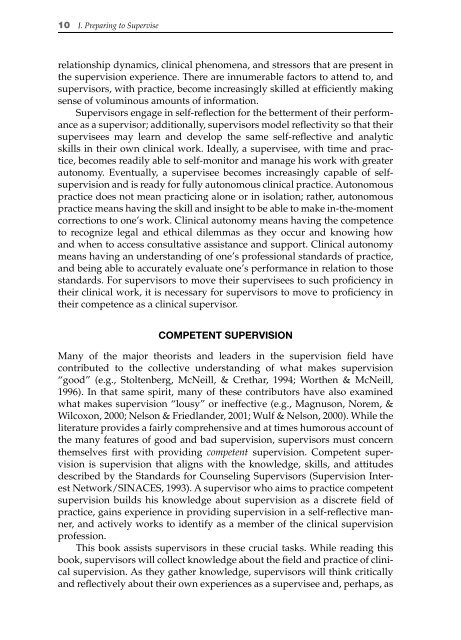ISBN 978-0-8261-0786-2 - Springer Publishing
ISBN 978-0-8261-0786-2 - Springer Publishing
ISBN 978-0-8261-0786-2 - Springer Publishing
You also want an ePaper? Increase the reach of your titles
YUMPU automatically turns print PDFs into web optimized ePapers that Google loves.
10 I. Preparing to Supervise<br />
relationship dynamics, clinical phenomena, and stressors that are present in<br />
the supervision experience. There are innumerable factors to attend to, and<br />
supervisors, with practice, become increasingly skilled at efficiently making<br />
sense of voluminous amounts of information.<br />
Supervisors engage in self-reflection for the betterment of their performance<br />
as a supervisor; additionally, supervisors model reflectivity so that their<br />
supervisees may learn and develop the same self- reflective and analytic<br />
skills in their own clinical work. Ideally, a supervisee, with time and practice,<br />
becomes readily able to self-monitor and manage his work with greater<br />
autonomy. Eventually, a supervisee becomes increasingly capable of selfsupervision<br />
and is ready for fully autonomous clinical practice. Autonomous<br />
practice does not mean practicing alone or in isolation; rather, autonomous<br />
practice means having the skill and insight to be able to make in-the-moment<br />
corrections to one’s work. Clinical autonomy means having the competence<br />
to recognize legal and ethical dilemmas as they occur and knowing how<br />
and when to access consultative assistance and support. Clinical autonomy<br />
means having an understanding of one’s professional standards of practice,<br />
and being able to accurately evaluate one’s performance in relation to those<br />
standards. For supervisors to move their supervisees to such proficiency in<br />
their clinical work, it is necessary for supervisors to move to proficiency in<br />
their competence as a clinical supervisor.<br />
COMPETENT SUPERVISION<br />
Many of the major theorists and leaders in the supervision field have<br />
contributed to the collective understanding of what makes supervision<br />
“good” (e.g., Stoltenberg, McNeill, & Crethar, 1994; Worthen & McNeill,<br />
1996). In that same spirit, many of these contributors have also examined<br />
what makes supervision “lousy” or ineffective (e.g., Magnuson, Norem, &<br />
Wilcoxon, 2000; Nelson & Friedlander, 2001; Wulf & Nelson, 2000). While the<br />
literature provides a fairly comprehensive and at times humorous account of<br />
the many features of good and bad supervision, supervisors must concern<br />
themselves first with providing competent supervision. Competent supervision<br />
is supervision that aligns with the knowledge, skills, and attitudes<br />
described by the Standards for Counseling Supervisors (Supervision Interest<br />
Network/SINACES, 1993). A supervisor who aims to practice competent<br />
supervision builds his knowledge about supervision as a discrete field of<br />
practice, gains experience in providing supervision in a self-reflective manner,<br />
and actively works to identify as a member of the clinical supervision<br />
profession.<br />
This book assists supervisors in these crucial tasks. While reading this<br />
book, supervisors will collect knowledge about the field and practice of clinical<br />
supervision. As they gather knowledge, supervisors will think critically<br />
and reflectively about their own experiences as a supervisee and, perhaps, as

















